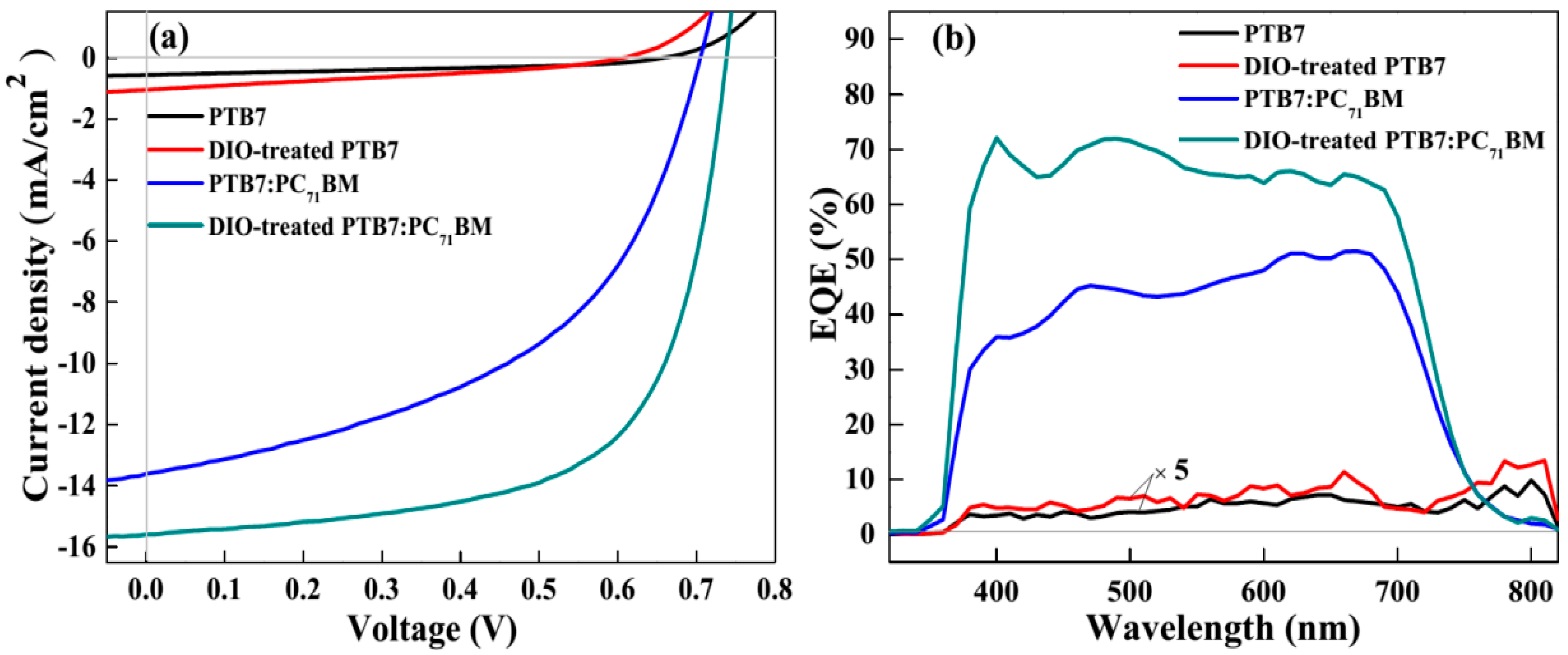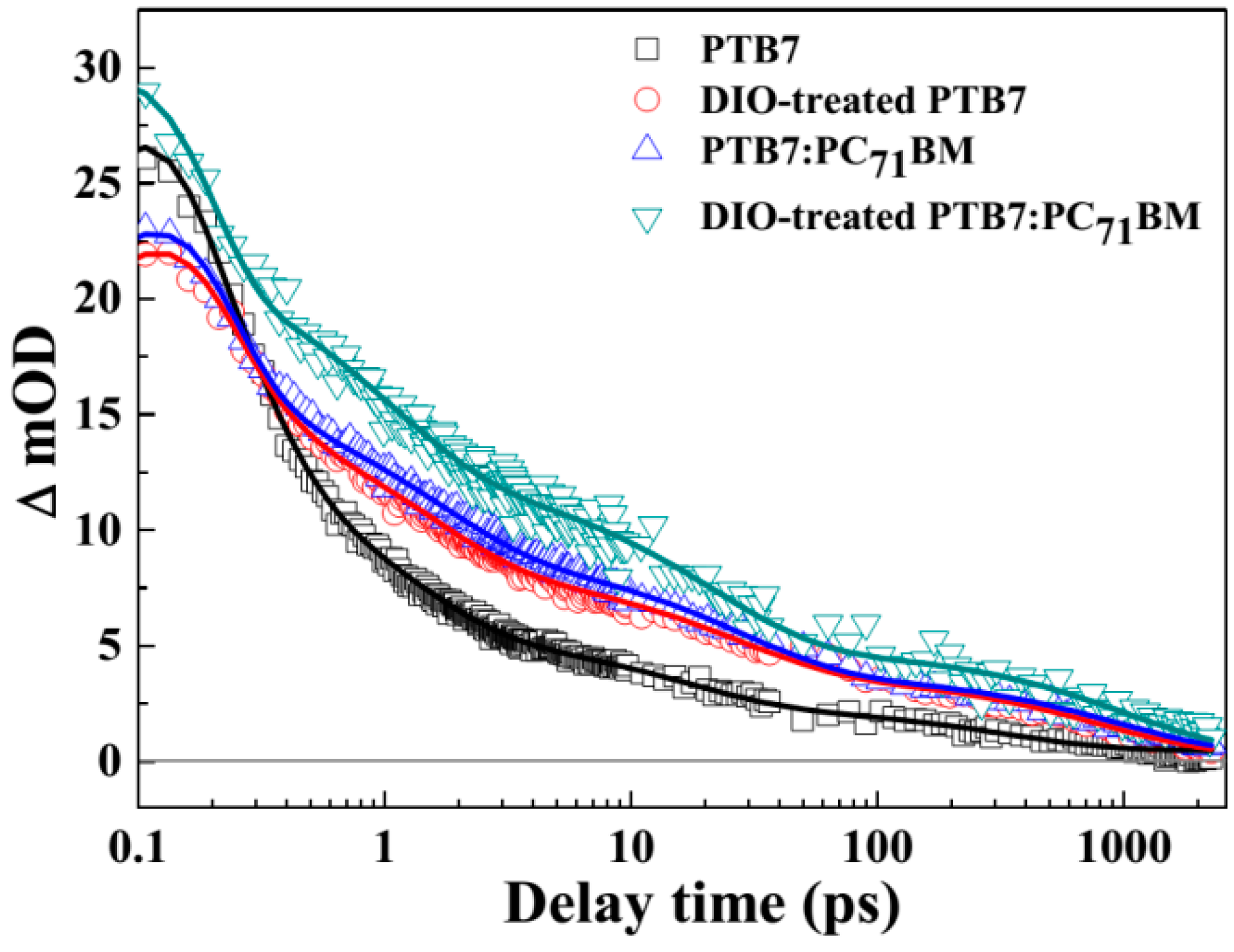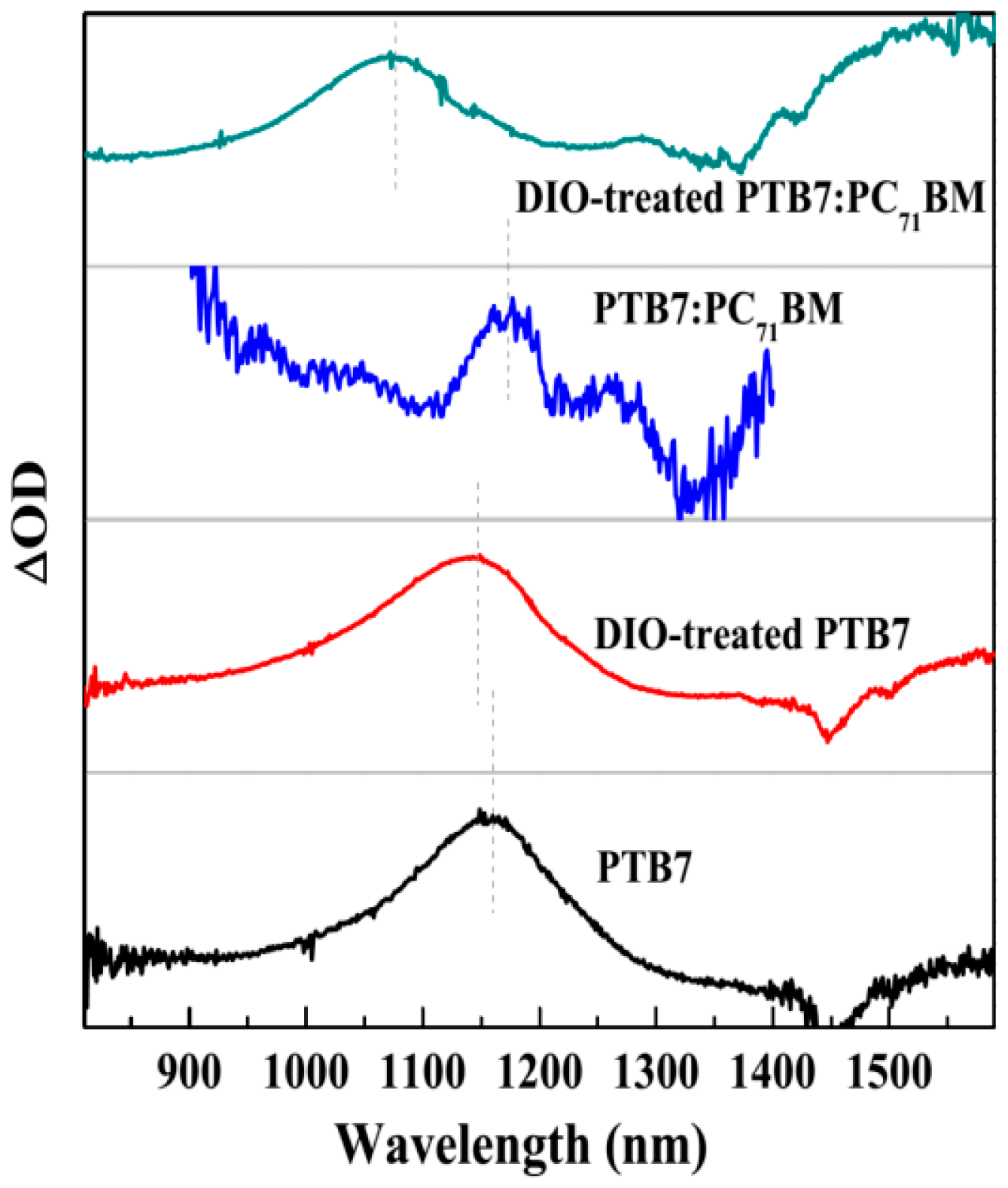Appropriate Donor-Acceptor Phase Separation Structure for the Enhancement of Charge Generation and Transport in Polymer Solar Cells
Abstract
:1. Introduction
2. Experimental
2.1. Fabrication of PSCs Devices
2.2. J-V Measurement and EQE Measurement
2.3. Optical and Structure Characterization
2.4. Spectroelectrochemistry Test (SEC) and Time-Resolved Absorption Measurements (TA)
3. Results and Discussion
3.1. Photovoltaic Performance of PTB7-Based Devices
3.2. Steady-State Absorption Spectra of PTB7-Based Active Layers
3.3. Morphological Characterization of PTB7-Based Active Layers
3.4. Effect of Concentration, PC71BM and DIO Additive on Aggregation State of PTB7 in Solution
3.5. Charge Generation and Lifetime in PTB7-Based Active Layers
3.6. Charge Transport Characteristic in PTB7-Based Active Layers
4. Conclusions
Supplementary Materials
Acknowledgments
Author Contributions
Conflicts of Interest
References
- Zheng, Y.; Huang, J.; Wang, G.; Kong, J.; Huang, D.; Mohadjer Beromi, M.; Hazari, N.; Taylor, A.D.; Yu, J. A highly efficient polymer non-fullerene organic solar cell enhanced by introducing a small molecule as a crystallizing-agent. Mater. Today 2018. [Google Scholar] [CrossRef]
- Liu, Z.; Wu, Y.; Zhang, Q.; Gao, X. Non-fullerene small molecule acceptors based on perylene diimides. J. Mater. Chem. A 2016, 4, 17604–17622. [Google Scholar] [CrossRef]
- Fan, P.; Zheng, Y.; Zheng, D.; Yu, J. Improved efficiency of bulk heterojunction polymer solar cells by doping with iridium complex. Mater. Lett. 2017, 186, 161–164. [Google Scholar] [CrossRef]
- Huang, J.; Carpenter, J.H.; Li, C.Z.; Yu, J.S.; Ade, H.; Jen, A.K. Highly efficient organic solar cells with improved vertical donor-acceptor compositional gradient via an inverted off-center spinning method. Adv. Mater. 2016, 28, 967–974. [Google Scholar] [CrossRef] [PubMed]
- Zhao, W.; Li, S.; Zhang, S.; Liu, X.; Hou, J. Ternary polymer solar cells based on two acceptors and one donor for achieving 12.2% efficiency. Adv. Mater. 2017, 29, 1604059. [Google Scholar] [CrossRef] [PubMed]
- Zheng, Y.; Goh, T.; Fan, P.; Shi, W.; Yu, J.; Taylor, A.D. Toward efficient thick active PTB7 photovoltaic layers using diphenyl ether as a solvent additive. ACS Appl. Mater. Interfaces 2016, 8, 15724–15731. [Google Scholar] [CrossRef] [PubMed]
- Huang, J.; Wang, H.; Yan, K.; Zhang, X.; Chen, H.; Li, C.-Z.; Yu, J. Highly efficient organic solar cells consisting of double bulk heterojunction layers. Adv. Mater. 2017, 29. [Google Scholar] [CrossRef] [PubMed]
- Zhao, W.; Qian, D.; Zhang, S.; Li, S.; Inganas, O.; Gao, F.; Hou, J. Fullerene-free polymer solar cells with over 11% efficiency and excellent thermal stability. Adv. Mater. 2016, 28, 4734–4739. [Google Scholar] [CrossRef] [PubMed]
- Zieleniewska, A.; Lodermeyer, F.; Roth, A.; Guldi, D.M. Fullerenes—How 25 years of charge transfer chemistry have shaped our understanding of (interfacial) interactions. Chem. Soc. Rev. 2018. [Google Scholar] [CrossRef] [PubMed]
- Srinivasan, M.V.; Ito, M.; Kumar, P.; Abhirami, K.; Tsuda, N.; Yamada, J.; Shin, P.-K.; Ochiai, S. Performance evaluation of an organic thin-film solar cell of PTB7:PC71BM with an alcohol-soluble polyelectrolyte interlayer prepared using the spray-coating method. Ind. Eng. Chem. Res. 2015, 54, 181–187. [Google Scholar] [CrossRef]
- Yu, J.; Zheng, Y.; Huang, J. Towards high performance organic photovoltaic cells: A review of recent development in organic photovoltaics. Polymers 2014, 6, 2473–2509. [Google Scholar] [CrossRef]
- Wen, S.; Wu, Y.; Wang, Y.; Li, Y.; Liu, L.; Jiang, H.; Liu, Z.; Yang, R. Pyran-bridged indacenodithiophene: A novel building block for constructing efficient A-D-A type nonfullerene acceptor for polymer solar cells. ChemSusChem 2018, 11, 360–366. [Google Scholar] [CrossRef] [PubMed]
- Liu, Z.; Zhang, L.; Shao, M.; Wu, Y.; Zeng, D.; Cai, X.; Duan, J.; Zhang, X.; Gao, X. Finely tuning the quasi-3D geometry: Enabling efficient non-fullerene organic solar cells based on perylene diimides. ACS Appl. Mater. Interfaces 2018, 10, 762–768. [Google Scholar] [CrossRef] [PubMed]
- Agostinelli, T.; Ferenczi, T.A.M.; Pires, E.; Foster, S.; Maurano, A.; Müller, C.; Ballantyne, A.; Hampton, M.; Lilliu, S.; Campoy-Quiles, M.; et al. The role of alkane dithiols in controlling polymer crystallization in small band gap polymer:Fullerene solar cells. J. Polym. Sci. Part B Polym. Phys. 2011, 49, 717–724. [Google Scholar] [CrossRef]
- Kim, W.; Kim, J.K.; Kim, E.; Ahn, T.K.; Wang, D.H.; Park, J.H. Conflicted effects of a solvent additive on PTB7:PC71BM bulk heterojunction solar cells. J. Phys. Chem. C 2015, 119, 5954–5961. [Google Scholar] [CrossRef]
- Do, K.; Ravva, M.K.; Wang, T.; Brédas, J.-L. Computational methodologies for developing structure–morphology–performance relationships in organic solar cells: A protocol review. Chem. Mater. 2016, 29, 346–354. [Google Scholar] [CrossRef]
- Szarko, J.M.; Rolczynski, B.S.; Lou, S.J.; Xu, T.; Strzalka, J.; Marks, T.J.; Yu, L.; Chen, L.X. Photovoltaic function and exciton/charge transfer dynamics in a highly efficient semiconducting copolymer. Adv. Funct. Mater. 2014, 24, 10–26. [Google Scholar] [CrossRef]
- Sharma, R.; Lee, H.; Gupta, V.; Kim, H.; Kumar, M.; Sharma, C.; Chand, S.; Yoo, S.; Gupta, D. Photo-physics of PTB7, PCBM and ICBA based ternary solar cells. Org. Electron. 2016, 34, 111–117. [Google Scholar] [CrossRef]
- Zhang, W.; Wang, Y.-W.; Hu, R.; Fu, L.-M.; Ai, X.-C.; Zhang, J.-P.; Hou, J.-H. Mechanism of primary charge photogeneration in polyfluorene copolymer/fullerene blends and influence of the donor/acceptor lowest unoccupied molecular orbital level offset. J. Phys. Chem. C 2013, 117, 735–749. [Google Scholar] [CrossRef]
- Huang, Y.; Guo, X.; Liu, F.; Huo, L.; Chen, Y.; Russell, T.P.; Han, C.C.; Li, Y.; Hou, J. Improving the ordering and photovoltaic properties by extending pi-conjugated area of electron-donating units in polymers with D-A structure. Adv. Mater. 2012, 24, 3383–3389. [Google Scholar] [CrossRef] [PubMed]
- An, Q.; Zhang, F.; Zhang, J.; Tang, W.; Deng, Z.; Hu, B. Versatile ternary organic solar cells: A critical review. Energy Environ. Sci. 2016, 9, 281–322. [Google Scholar] [CrossRef]
- Sprau, C.; Buss, F.; Wagner, M.; Landerer, D.; Koppitz, M.; Schulz, A.; Bahro, D.; Schabel, W.; Scharfer, P.; Colsmann, A. Highly efficient polymer solar cells cast from non-halogenated xylene/anisaldehyde solution. Energy Environ. Sci. 2015, 8, 2744–2752. [Google Scholar] [CrossRef]
- Bencheikh, F.; Duché, D.; Ruiz, C.M.; Simon, J.-J.; Escoubas, L. Study of optical properties and molecular aggregation of conjugated low band gap copolymers: PTB7 and PTB7-Th. J. Phys. Chem. C 2015, 119, 24643–24648. [Google Scholar] [CrossRef]
- Nguyen, T.-Q.; Doan, V.; Schwartz, B.J. Conjugated polymer aggregates in solution: Control of interchain interactions. J. Chem. Phys. 1999, 110, 4068–4078. [Google Scholar] [CrossRef]
- Wolfgang, H.; Nguyen, T.K.; Thanh, J.A.; David, G.F. Determination of size and concentration of gold nanoparticles from UV-Vis spectra. Anal. Chem. 2007, 79, 4215–4221. [Google Scholar]
- Zhang, W.; Hu, R.; Li, D.; Huo, M.-M.; Ai, X.-C.; Zhang, J.-P. Primary dynamics of exciton and charge photogeneration in solvent vapor annealed P3HT/PCBM films. J. Phys. Chem. C 2012, 116, 4298–4310. [Google Scholar] [CrossRef]
- Hu, R.; Ni, H.; Wang, Z.; Liu, Y.; Liu, H.; Yang, X.; Cheng, J. Spectroelectrochemical evidence for the effect of phase structure and interface on charge behavior in poly(3-hexylthiophene): Fullerene active layer. Chem. Phys. 2016, 476, 29–35. [Google Scholar] [CrossRef]
- Moon, H.; Seong, H.; Shin, W.C.; Park, W.T.; Kim, M.; Lee, S.; Bong, J.H.; Noh, Y.Y.; Cho, B.J.; Yoo, S.; et al. Synthesis of ultrathin polymer insulating layers by initiated chemical vapour deposition for low-power soft electronics. Nat. Mater. 2015, 14, 628–635. [Google Scholar] [CrossRef] [PubMed]
- Hu, R.; Zhang, W.; Fu, L.-M.; Zhang, J.-P.; Ai, X.-C. Spectroelectrochemical characterization of anionic and cationic polarons in poly(3-hexylthiophene)/fullerene blend. Effects of morphology and interface. Synth. Met. 2013, 169, 41–47. [Google Scholar] [CrossRef]
- Supasai, T.; Amornkitbamrung, V.; Thanachayanont, C.; Tang, I.M.; Sutthibutpong, T.; Rujisamphan, N. Visualizing nanoscale phase morphology for understanding photovoltaic performance of PTB7:PC71BM solar cell. Appl. Surf. Sci. 2017, 422, 509–517. [Google Scholar] [CrossRef]
- Huang, W.; Zhuang, X.; Melkonyan, F.S.; Wang, B.; Zeng, L.; Wang, G.; Han, S.; Bedzyk, M.J.; Yu, J.; Marks, T.J.; et al. UV-ozone interfacial modification in organic transistors for high-sensitivity NO2 detection. Adv. Mater. 2017, 29. [Google Scholar] [CrossRef] [PubMed]
- Wang, H.; Huang, J.; Xing, S.; Yu, J. Improved mobility and lifetime of carrier for highly efficient ternary polymer solar cells based on tips-pentacene in PTB7:PC71BM. Org. Electron. 2016, 28, 11–19. [Google Scholar] [CrossRef]








| Active Layers | Jsc (mA/cm2) | Voc (V) | FF (%) | PCE (%) | PCE-Max a (%) |
|---|---|---|---|---|---|
| PTB7 | 0.53 (±0.04) | 0.64 (±0.02) | 36.3 (±0.7) | 0.13 (±0.01) | 0.14 |
| DIO-treated PTB7 | 0.73 (±0.10) | 0.60 (±0.02) | 32.4 (±0.6) | 0.17 (±0.02) | 0.19 |
| PTB7:PC71BM | 13.44 (±0.18) | 0.70 (±0.01) | 48.5 (±0.5) | 4.52 (±0.22) | 4.74 |
| DIO-treated PTB7:PC71BM | 15.45 (±0.16) | 0.71 (±0.02) | 64.7 (±0.3) | 7.30 (±0.11) | 7.41 |
| Active Layers | Fitting Parameters and Apparent Lifetimes | |||||||
|---|---|---|---|---|---|---|---|---|
| a1 | τ1 | a2 | τ2 | a3 | τ3 | a4 | τ4 | |
| PTB7 | 28.5 | 0.17 ± 0.04 | 8.1 | 1.7 ± 0.4 | 3.2 | 15.7 ± 1.5 | 1.9 | 332.9 ± 133.8 |
| DIO-treated PTB7 | 23.6 | 0.12 ± 0.03 | 7.7 | 1.4 ± 0.2 | 4.5 | 25.8 ± 5.5 | 3.4 | 815.9 ± 141.2 |
| PTB7:PC71BM | 31.4 | 0.10 ± 0.03 | 7.4 | 1.5 ± 0.2 | 5.2 | 27.2 ± 4.9 | 3.6 | 995.7 ± 158.2 |
| DIO-treated PTB7:PC71BM | 18.3 | 0.24 ± 0.01 | 10.1 | 1.0 ± 0.2 | 7.5 | 20.0 ± 4.3 | 4.4 | 1054.2 ± 235.1 |
| Charge Carrier | PTB7 | DIO-Treated PTB7 | PTB7:PC71BM | DIO-Treated PTB7:PC71BM |
|---|---|---|---|---|
| Hole (cm2·V−1·s−1) | 2.60 (±0.1) × 10−4 | 3.06 (±0.1) × 10−4 | 5.25 (±0.15) × 10−5 | 5.60 (±0.15) × 10−5 |
| Electron (cm2·V−1·s−1) | 6.96 (±0.1) × 10−7 | 1.13 (±0.1) ×10−6 | 5.48 (±0.1) × 10−5 | 8.92 (±0.1) × 10−4 |
© 2018 by the authors. Licensee MDPI, Basel, Switzerland. This article is an open access article distributed under the terms and conditions of the Creative Commons Attribution (CC BY) license (http://creativecommons.org/licenses/by/4.0/).
Share and Cite
Zhang, D.; Hu, R.; Cheng, J.; Chang, Y.; Huo, M.; Yu, J.; Li, L.; Zhang, J.-P. Appropriate Donor-Acceptor Phase Separation Structure for the Enhancement of Charge Generation and Transport in Polymer Solar Cells. Polymers 2018, 10, 332. https://doi.org/10.3390/polym10030332
Zhang D, Hu R, Cheng J, Chang Y, Huo M, Yu J, Li L, Zhang J-P. Appropriate Donor-Acceptor Phase Separation Structure for the Enhancement of Charge Generation and Transport in Polymer Solar Cells. Polymers. 2018; 10(3):332. https://doi.org/10.3390/polym10030332
Chicago/Turabian StyleZhang, Dayong, Rong Hu, Jiang Cheng, Yuqiang Chang, Mingming Huo, Junsheng Yu, Lu Li, and Jian-Ping Zhang. 2018. "Appropriate Donor-Acceptor Phase Separation Structure for the Enhancement of Charge Generation and Transport in Polymer Solar Cells" Polymers 10, no. 3: 332. https://doi.org/10.3390/polym10030332





